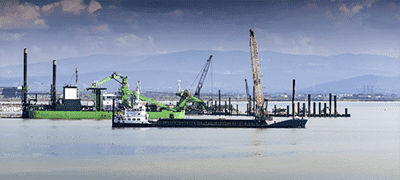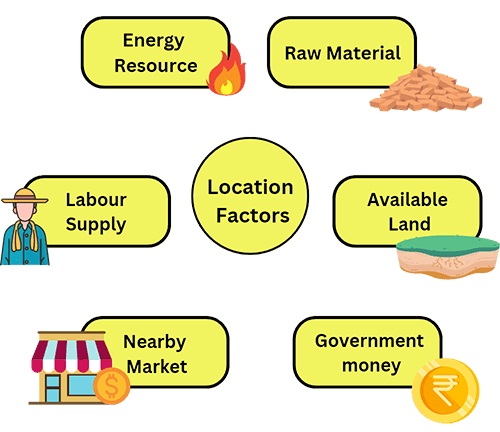Boost Your CBSE Class 8 Industries Understanding: Worksheets & Solutions for 2025-26 Exam Prep
To understand the different concepts of Chapter 5 in geography, students can take help from various pdfs and worksheets. SST is a broad subject, and to understand it properly, students might need the help of different study materials. One such chapter in geography is Industries. In this lesson, learners will learn about the formation of various industries and how they affect the country's economic conditions. Students will learn about different industries, like coal, iron, steel etc.
Practice papers and worksheets are the best way to learn and revise any chapter. It will help Class 8 students to clear various doubts regarding the chapter. As pdfs are the new way of preparing for the lessons, learners can effectively use the Geography Class 8 Manufacturing Industries pdf. To score maximum marks in the exam, it is best that the students should follow and refer to nicely curated study materials and pdfs based on the latest CBSE pattern.
Access Worksheet for Class 8 Geography Chapter 5 - Industries
1. What is the industry?
2. What is Manufacturing?
3. What are Raw Materials?
4. Agro-based industries?
5. What are Mineral based industries?
6. What are Marine based industries?

Marine
7. What are Forest-based industries?
8. What are the primary elements influencing an industry's location?
9. What sector is frequently said to as the foundation of the current industry, and why?.
10. Why has Mumbai's cotton textile sector grown so quickly?
11. List the top three techniques used to categorize industries.
12. Expand the AMUL acronym. Where is the company's headquarters?
13. Give the names of four typical processes used in the textile industry.
14. Which category does manufacturing fall under in terms of economic activity?
Primary
Secondary
Tertiary
Primary as well as secondary
15. Which industry serves as the foundation for all others?
Cotton textile industry
Leather industry
Iron and steel industry
IT industry
16. Which industry serves as the foundation for all others?
Cotton textile industry
Leather industry
Iron and steel industry
IT industry
17. Which industry category does Mamti Udyog belong to?
Joint sector
Private sector
Public sector
Cooperative sector
18. Which industry category does Mamti Udyog belong to?
Joint sector
Private sector
Public sector
Cooperative sector
19. What is the name of the place where TISCO began?
Kharkiv
Calcutta
Sakchi
Rourkela
20. Fill in the Blanks:
The river that supplies Osaka's textile industry with enough water is _______.
A_________ industry includes things like pottery, handicrafts, and basket weaving.
Regions like the Mumbai-Pune cluster and the Chhotanagpur belt are important regions of India.
The smelting process can be carried out in a ________.
The________ mountains are close to Silicon Valley.
21. State True and false:
Silicon Valley is located in Ahmedabad.
The Information Technology industry is known as the sunrise industry.
Jute is a natural fibre.
An industry that depends on forests is the leather industry.
Small-scale industries are characterized by limited resources and infrastructure.
22. Match the column:
Column I | Column II |
Silicon Valley | (a) Mumbai |
Silicon Plateau | (b) California |
First successful textile mill | (c) Sakchi |
Initiation of TISCO | (d) Osaka |
Manchester of Japan | (e) Bangalore |
23. Differentiate the following into:
Industries based on agriculture and minerals
Public and joint sectors of the economy
24. Write short note on the Pittsburgh area's iron and steel sector.
25. Give the names of two natural and two synthetic fibers.
Answer:
1. An economic activity that is focused on the creation of goods, the extraction of minerals, or the delivery of services is referred to as an "industry.
2. Materials become products through secondary or manufacturing processes. At every step of the manufacturing process, value is added to the pulp-based paper and cotton-based fabric. The final product will be more valuable and useful as a result.
3. Raw Materials: Depending on the kind of raw materials and industrial uses, they may be agro-based, mineral-based, marine-based, or forest-based.
4. Plant- and animal-based goods serve as the raw materials for agro-based enterprises. Examples of agro-based industries include the food processing, vegetable oil, cotton textile, dairy, and leather industries
5. Primary industries that employ mineral ores as their raw materials are known as mineral-based industries. These industries' output fuels other industries. An industry based on minerals produces iron from iron ore.
6. Ocean and sea products are used as raw materials by industries situated in the marine environment. Examples are businesses that produce fish oil or process seafood.
7. Forest products are used as raw resources by industries situated in forests. Pulp and paper, medications, furniture, and buildings are industries connected to the wood.
8. The accessibility of raw resources, land, water, labor, power, capital, transportation, and markets has an impact on where industries are located.

Raw resources
9. Steel is a primary component of vehicles like ships, trains, lorries, and cars. From safety pins to huge ships, steel is employed in a variety of products.
With the help of steel machinery, oil wells are dug.
Oil is moved through steel pipelines.
Steel-based machinery is used to mine minerals.
The majority of farm machinery is constructed of steel.
Steel frames support large buildings.
10. Because of the abundance of favorable conditions, the Mumbai cotton textile industry grew quickly at first. This was made possible by the area's humid and hot environment, a nearby port for importing machinery, the simplicity of obtaining raw materials, and competent labor
11. Industries are classified according to the type of raw material used, their size, and who owns them.
12. The ANMilk Union Limited. Its main office is in Anand, Gujarat.
13. The textile industry uses ginseng, spinning, weaving, and dyeing as processes.
14. Secondary
15. IT Sector
16. Iron and steel industry.
17. Joint sector
18. All of these
19. Sacchi
20.
Yodo
small-scale
industrial
blast furnace
Rocky
21.
False
True
True
True
True
22.
Silicon Valley - California
Silicon Plateau - Bangalore
First successful textile mill - Mumbai
Initiation of TISCO - Sakchi
Manchester of Japan - Osaka
23. Following are the difference between agro-based industry and mineral-based industry:
Agro-based industry | Mineral-based industry |
Agro-based industries use plant and animal-based products as their raw material. | Mineral-based industries use mineral ores as their raw material. |
Examples of raw materials used: are animal skin and crops. | Examples of raw materials used: are iron ore and limestone. |
Examples of industries: are the leather industry and food processing. | Examples of industries: the iron and steel industry. |
Following are the difference between public sector industry and joint sector industry:
Public sector industry | Joint sector industry |
Public sector industries are owned and run by the government. | Joint sector industries are owned and operated by the state as well as individuals. |
Examples: Hindustan Aeronautics Limited. | Examples: Maruti Udyog. |
24. In the USA, Pittsburgh is a significant steel city. The majority of basic commodities, including coal, are accessible locally. From Minnesota's iron mines, iron ore is transported. The Great Lakes of North America serve as a practical route for ore shipping. Trains transport the ore from the lakes to the industrial region. Ample water resources are provided by rivers like the Allegheny, Ohio, and the Monogahela. Both land and marine routes are used to transfer finished steel to markets.
25. Silk and wool are examples of natural fibers. Two man-made fibers are nylon and polyester.
Benefits of Referring to the Geography Class 8 Manufacturing Industries PDF
Some benefits of referring to the worksheets and PDFs for preparing the chapter industries are listed below:
With the help of pdf, students can easily solve any doubts and questions about the chapter, like which city has emerged as the electronic capital of India and other tough subtopics.
Pdfs are very compact and easy to carry. Students do not have to hassle between multiple notebooks and papers. In addition, these pdfs also contain MCQ on Class 8 Industries lessons which students can solve to understand the chapter in a better way.
Students can struggle to grasp some topics in the lesson industries; therefore, learners should use online study materials as they are easily accessible and can be directly opened in PDF format for last-minute revision.
There are different questions and answers on Industries Class 8 in this chapter, and it can be hard to find a proper storage place for all the physical notes and the pdfs have the advantage over the storage issue.
Another advantage of using worksheets and pdfs is that students can use them anytime, anywhere, making it easy for them to memorise the lesson freely.
It is not easy for the learners to find different practice papers to boost up their preparation, but with Industries Class 8 worksheets, students can easily refer to different practice papers and exercises in one place in a systematic manner.
Examples and Exercises Based on the Geography Class 8 Manufacturing Industries PDF
Here are some questions and exercises based on the lesson Industries.
1. Answer the following questions in brief.
Which city has emerged as the electronic capital of India?
Which sector is the backbone of the Indian economy?
Where was the first jute mill set up in India?
Write a note on small-scale industries.
2. Fill in the blanks.
The first cotton textile mill in India was established in ____.
_____ river provides water to the Okasa industry.
The first modern textile mill was established in ____.
Silicon Valley is a part of _______.
Avail a Free PDF with MCQ on Class 8 Industries
PDFs have different MCQs and exercises on the particular topic, which will help students to understand difficult questions like which city has emerged as the electronic capital of India and more. Learners can use the worksheet and PDFs as the layout for the whole chapter.
Students can quickly download the pdfs from the Vedantu website and use them to revise various Industries Class 8 questions and answers.
Our PDFs are the best way to crack the exam with flying colours because they are based on the Class 8 exam pattern.
Learners can use the pdf directly from the website or print it for convenience.
The PDF contains all the latest question answers and exercises covering all the chapter's vital topics.
Lastly, we hope that after reading this article, students will solve some sample questions and download the pdf and worksheets to speed up the preparations. After much research, the expert teachers at Vedantu have made well-formatted PDFs for the chapter Industries with Industries Class 8 worksheets. We encourage all the students to use these pdfs to get important insights into the lesson and score good marks.
FAQs on Practice CBSE Class 8 Geography Chapter 5 Industries Worksheet – Free PDF 2025-26
1. What are industries?
The industry refers to a place where all the economic activities concerning the production of goods, extraction of minerals, etc. take place.
2. How can students make effective use of PDFs in their studies?
The best way to use the PDFs for studying social science in Class 8 is to practise the daily question papers and worksheets given in the PDFs. It will help the students to remember the chapter easily.
3. What are two common types of industries based on size?
The two common types of industries based on size are small-scale and large-scale industries.


















